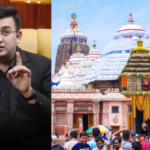Delhi court sends 26/11 attack accused Tahawwur Hussain Rana to 18-day NIA custody
NEW DELHI, APR 11: A special National Investigation Agency (NIA) court has granted 18 days custody of Tahawwur Rana to NIA for interrogation.
The anti-terror agency had produced Rana before the NIA Special Court at Patiala House after formally placing him under arrest on his arrival at Indira Gandhi International (IGI) airport here on Thursday evening, following his successful extradition from the US.
Rana was brought to the Patiala House Court amid tight security, accompanied by a convoy that included a prison van, a Mahindra Marksman armoured SWAT vehicle, and an ambulance.
He appeared before Special NIA Judge Chander Jit Singh, who granted the custody.
The NIA had initially requested 20 days of custody for Rana, referring to key pieces of evidence such as email communications, according to sources.
In its submission to the court, the agency argued that Rana’s custodial interrogation was essential to probe a suspected conspiracy. It alleged that Rana had collaborated with others in a criminal plot aimed at carrying out terrorist activities.
During the proceedings, the court enquired whether Rana wished to engage a private lawyer or preferred legal aid to be provided by the court.
Senior Advocate Dayan Krishnan, appearing for the NIA, informed the court that Rana’s custody was necessary to verify and substantiate existing evidence and related facts.
Krishnan also submitted the remand application on behalf of the NIA, outlining the charges against Rana and presenting a list of evidence for the judge’s consideration.
The NIA also told the court that Headley had emailed Rana a detailed list of his possessions and resources in anticipation of possible complications. The communication, the agency claimed, also revealed the roles of other accused, including Ilyas Kashmiri and Abdur Rehman.
Ahead of the production of Rana before the court, the Delhi Police removed mediapersons and members of the public from the court premises, citing security concerns. While asking the mediapersons to leave, police said it was ensuring that the court premises was fully vacant.
Police authorities cited security and safety concerns for restricting people’s access to the court complex, and said “no one would be permitted inside”.
“With the active assistance of USDoJ, the US Sky Marshal, NIA worked closely with other Indian intelligence agencies, NSG through the entire extradition process, which also saw India’s Ministry of External Affairs and Ministry of Home Affairs coordinating with the other relevant authorities in the United States to take the matter to its successful conclusion”, the statement read.
Rana will be taken under tight security to the headquarters of the NIA, where a high-security cell has been readied for his interrogation. He will be put on trial for his alleged involvement in the 26/11 attacks, which claimed 166 lives during a coordinated three-day assault on Mumbai.
A high-powered team of 12 National Investigation Agency (NIA) officials—including the Director General, two Inspector Generals, one Deputy Inspector General, and a Superintendent of Police—will begin questioning Rana.
According to NIA sources, only these 12 officials involved directly in the probe will be granted access to Rana’s cell. Any other officer would need prior permission. Among those in the core team are NIA DG Sadanand Date, IG Ashish Batra, and DIG Jaya Roy.
Rana will be shown a range of material, including recorded voice samples, photographs, videos, and email trails, some of which are expected to establish his links to Pakistan’s intelligence network and terror operatives.
Rana’s arrival, cloaked in a dense security blanket, comes just hours after Pakistan’s Foreign Office issued a carefully worded video statement distancing itself from him.
The statement declared that Rana had not renewed any Pakistani documentation in the last two decades and that his Canadian nationality was “very clear.”
Sources in India’s intelligence establishment believe the Pakistani Foreign Office’s abrupt distancing is no coincidence. Rana, they assert, holds vital knowledge of Pakistan’s military-intelligence apparatus and its hand in orchestrating the Mumbai attacks.
His known ties to Pakistan’s Inter-Services Intelligence (ISI) and the Army make him a potential mine of damning testimony that could expose the state’s role in the 26/11 attacks.
“Pakistan fears Rana will spill the beans… this sudden disavowal is nothing but strategic panic,” said a senior counter-terror official.
Meanwhile, Israel on Thursday hailed the extradition of Tahawwur Rana.
“I would like to thank the Government of India for its persistence in bringing the terrorists to justice,” Israel’s Ambassador to India, Reuven Azar said in a statement.
Rana’s extradition is the culmination of a lengthy legal and diplomatic struggle that saw Indian authorities pressing the United States under the 1997 India-US Extradition Treaty. After years of litigation, the US Supreme Court dealt the final blow to Rana’s attempts to evade deportation by rejecting his plea for a stay.
In a blunt order, the apex court ruled, “The application for stay addressed to the Chief Justice and referred to the Court is denied.”
Rana’s lawyers had pleaded that extraditing him would violate the UN Convention Against Torture due to his Pakistani-Muslim background and the politically sensitive nature of the case. The court, however, found the arguments unconvincing.
(L) Tahawwur Rana being brought to Patiala house court in New Delhi (R) Rana arrives at Delhi airport after extradition from the US.
Tahawwur Rana’s extradition: Delhi court recieves 26/11 Mumbai attack case files, documents
Authorities have yet to finalise Rana’s place of incarceration, with both Mumbai’s Arthur Road Jail and Delhi’s Tihar Prison being considered. Jail authorities in both cities have been instructed to prepare high-security cells.
In a late-night notification, Centre has appointed advocate Narender Mann as special public prosecutor for conducting trial and other matters related to the National Investigation Agency (NIA) case RC-04/2009/NIA/DLI (Mumbai attacks) for three years.
“In exercise of the powers conferred by sub-section (1) of section 15 of the National Investigation Agency Act, 2008 (34 of 2008), read with sub-section (8) of section 18 of the Bharatiya Nagarik Suraksha Sanhita, 2023 (BNSS), the central government hereby appoints Narender Mann, advocate as special public prosecutor for conducting trial and other matters related to NIA case RC-04/2009/NIA/DLI on behalf of the National Investigation Agency before the NIA Special Courts at Delhi and Appellate Courts, for a period of three years from the date of publication of this notification or till the completion of trial of the said case, whichever is earlier,” the notification said.
Rana’s role in the Mumbai attacks stems from his close association with David Coleman Headley, the Pakistani-American operative who conducted reconnaissance missions for the Lashkar-e-Taiba (LeT) terror group. While a U.S. jury in 2011 acquitted Rana of direct involvement in the Mumbai carnage, it convicted him in a separate conspiracy to bomb the offices of the Danish newspaper Jyllands-Posten.
After serving a 14-year prison term in the U.S., Rana was re-arrested in 2020 following India’s renewed extradition request. Now, he faces charges in India ranging from conspiracy to terrorism and murder—charges that carry the possibility of the death penalty under Indian law.
According to intelligence inputs, Rana had visited several Indian cities, including Delhi, Hapur, Agra, Kochi, Ahmedabad, and Mumbai, with his wife Samraz Rana Akhtar in the days leading up to the November 2008 attacks. These visits, investigators believe, were not tourist excursions but part of a larger reconnaissance mission tied to the planned carnage.
“Once we interrogate Rana on Indian soil, we will be able to conclusively establish the purpose of these visits and the operational planning that led to the 26/11 attacks,” said an NIA source.
-PTI






